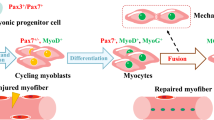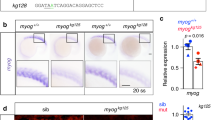Abstract
The regulation of muscle fibre transitions has mainly been studied in vivo using conventional histological or immunohistochemical techniques. In order to investigate the molecular regulation of myosin heavy chain (MyHC) isoform expression in cell culture studies, we first characterised the normal transitions in endogenous expression of the MyHC isoforms and the myogenic regulatory factors during differentiation of C2C12 muscle cells. Interestingly, across the time course of differentiation, MyHC mRNA isoforms were expressed in a distinct temporal pattern as two distinct cohorts, one including MyHC I, embryonic and neonatal, the other including MyHC IIa, IIx and IIb. The pattern of expression suggests a transition in MyHC isoforms, from one cohort to another, occurs during muscle cell differentiation and that these transitions occur independent of nerve innervation. To our knowledge, this is the most comprehensive analysis of in vitro MyHC mRNA isoform transitions and provides important information for studying the regulation of transitions in MyHC isoforms in cell culture systems.



Similar content being viewed by others

References
Agbulut O, Noirez P, Beaumont F, Butler-Browne G (2003) Myosin heavy chain isoforms in postnatal muscle development of mice. Biol Cell 95:399–406
Allen DL, Sartorius CA, Sycuro LK, Leinwand LA (2001) Different pathways regulate expression of the skeletal myosin heavy chain genes. J Biol Chem 276(47):43524–43533
Alway SE, Degens H, Lowe DA, Krishnamurthy G (2002) Increased myogenic repressor Id mRNA and protein levels in hindlimb muscles of aged rats. Am J Physiol Regul Integr Comp Physiol 282:411–422
Cerny LC, Bandman E (1986) Contractile activity is required for the expression of neonatal myosin heavy chain in embryonic chick pectoral muscle cultures. J Cell Biol 103(6):2153–2161
D’Antona G, Lanfranconi F, Pellegrino MA, Brocca L, Adami R, Rossi R et al (2006) Skeletal muscle hypertrophy and structure and function of skeletal muscle fibres in male body builders. J Physiol 570(Pt 3):611–627
Delbono O (2010) Myosin—still a good reference for skeletal muscle fibre classification? J Physiol 588(Pt 1):9
Ekmark M, Rana ZA, Stewart G, Hardie DG, Gundersen K (2007) De-phosphorylation of MyoD is linking nerve-evoked activity to fast myosin heavy chain expression in rodent adult skeletal muscle. J Physiol 584(Pt 2):637–650
Fahey AJ, Brameld JM, Parr T, Buttery PJ (2005) Ontogeny of factors associated with proliferation and differentiation of muscle in the ovine fetus. J Anim Sci 83:2330–2338
Gayraud-Morel B, Chrétien F, Flamant P, Gomès D, Zammit PS, Tajbakhsh S (2007) A role for the myogenic determination gene Myf5 in adult regenerative myogenesis. Dev Biol 312:13–28
Giger J, Qin AX, Bodell PW, Baldwin KM, Haddad F (2007) Activity of the β-myosin heavy chain antisense promoter responds to diabetes and hypothyroidism. Am J Physiol Heart Circ Physiol 292:3065–3071
Gunawan AM, Richert BT, Schinckel AP, Grant AL, Gerrard DE (2007) Ractopamine induces differential gene expression in porcine skeletal muscles. J Anim Sci 85:2115–2124
Harrison BC, Allen DL, Leinwand LA (2011) IIb or not IIb? Regulation of myosin heavy chain gene expression in mice and men. Skelet Muscle 1(5):1–9
Hasty P, Bradley A, Morris JH, Edmondson DH, Venuti JM, Olson EN, Klein WH (1993) Muscle deficiency and neonatal death in mice with a targeted mutation in the myogenin gene. Nature 364:501–506
Hughes SM, Taylor JM, Tapscott SJ, Gurley CM, Carter WJ, Peterson CA (1993) Selective accumulation of MyoD and Myogenin mRNAs in fast and slow adult skeletal muscle is controlled by innervation and hormones. Development 118:1137–1147
Hurley MS, Flux C, Salter AM, Brameld JM (2006) Effects of fatty acids on skeletal muscle differentiation in vitro. Br J Nutr 95:623–630
Kitzmann M, Carnac G, Vandromme M, Primig M, Lamb NJC, Fernandez A (1998) The muscle regulatory factors MyoD and Myf-5 undergo distinct cell cycle—specific expression in muscle cells. J Cell Biol 142(6):1447–1459
Lefaucheur L (2010) A second look into fibre typing—relation to meat quality. Meat Sci 84:257–270
Luther HP, Haase H, Hohaus A, Beckmann G, Reich J, Morano I (1998) Characterization of naturally occurring myosin heavy chain antisense mRNA in rat heart. J Cell Biochem 70:110–120
Matsakas A, Mouisel E, Amthor H, Patel K (2010) Myostatin knockout mice increase oxidative muscle phenotype as an adaptive response to exercise. J Muscle Res Cell Motil 31:111–125
Miller JB (1990) Myogenic programs of mouse muscle cell lines: expression of myosin heavy chain isoforms, myoD1, and myogenin. J Cell Biol 111:1149–1159
Nabeshima Y, Hanaoka K, Hayasaka M, Esumi E, Li S, Nonaka I, Nabeshima YI (1993) Myogenin gene disruption results in perinatal lethality because of sever muscle defect. Nature 364:532–535
Pandorf CE, Haddad F, Roy RR, Qin AX, Edgerton VR, Baldwin KM (2006) Dynamics of myosin heavy chain gene regulation in slow skeletal muscle—role of natural antisense RNA. J Biol Chem 281(50):38330–38342
Rhinn H, Scherman D, Escrio V (2008) One-step quantification of single-stranded DNA in the presence of RNA using Oligreen in a real-time polymerase chain reaction thermocycler. Anal Biochem 372:116–118
Rinaldi C, Haddad F, Bodell PW, Qin AX, Jiang W, Baldwin KM (2008) Intergenic bidirectional promoter and cooperative regulation of the IIx and IIb MHC genes in fast skeletal muscle. Am J Physiol Regul Integr Comp Physiol 295:208–218
Sabourin LA, Rudnicki MA (2000) The molecular regulation of myogenesis. Clin Genet 57:16–25
Sabourin LA, Girgis-Gabardo A, Seale P, Asakura A, Rudnicki MA (1999) Reduced differentiation potential of primary MyoD−/− myogenic cells derived from adult skeletal muscle. J Cell Biol 144(4):631–643
Silberstein L, Webster SG, Travis M, Blau HM (1986) Developmental progression of myosin gene expression in cultured muscle cells. Cell 46(7):1075–1081
Ustanina S, Carvajal J, Rigby P, Braun T (2007) The myogenic factor Myf5 supports efficient skeletal muscle regeneration by enabling transient myoblast amplification. Stem Cells 25:2006–2016
Voytik SL, Przyborski M, Badylak SF, Konieczny SF (1993) Differential expression of muscle regulatory factor genes in normal and denervated adult rat hindlimb muscles. Dev Dyn 198:214–224
Weydert A, Barton P, Harris JA, Pinset C, Buckingham M (1987) Development pattern of mouse myosin heavy chain gene transcripts in vivo and in vitro. Cell 49:121–129
Wheeler MT, Snyder EC, Patterson MN, Swoap SJ (1999) An E-box within the MHC IIB gene is bound by MyoD and is required for gene expression in fast muscle. Am J Physiol 276:1069–1078
Wimmers K, Ngu NT, Jennen DGJ, Tesfaye D, Murani E, Schellander K, Ponsuksili S (2008) Relationship between myosin heavy chain isoform expression and muscling in several diverse pig breeds. J Anim Sci 86:795–803
Wright WE, Sassoon DA, Lin VK (1989) Myogenin, a factor regulating myogenesis, has a domain homologous to myoD. Cell 56:607–617
Acknowledgments
The authors acknowledge the financial support provided by the Biotechnology and Biological Sciences Research Council (BBSRC) for this research.
Author information
Authors and Affiliations
Corresponding author
Electronic supplementary material
Below is the link to the electronic supplementary material.
Rights and permissions
About this article
Cite this article
Brown, D.M., Parr, T. & Brameld, J.M. Myosin heavy chain mRNA isoforms are expressed in two distinct cohorts during C2C12 myogenesis. J Muscle Res Cell Motil 32, 383–390 (2012). https://doi.org/10.1007/s10974-011-9267-4
Received:
Accepted:
Published:
Issue Date:
DOI: https://doi.org/10.1007/s10974-011-9267-4



